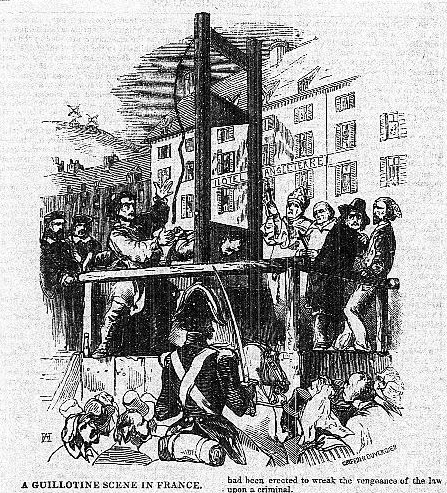Nikola Benin, Ph.D

To most people, Hugo will be familiar as the man who authored Les Miserables (1862), which during the 1980s was adapted in London’s West End’s longest-running and most successful musical. To those familiar with Hugo’s epic story, it will come as no surprise that he was an outspoken political activist who involved himself in many causes, and one of these was the abolition of the death penalty. Thus, in Hugo’s own words, The Last Day of a Condemned Man is,
nothing more than an appeal – direct or indirect, however you wish to see it – for the abolition of the death penalty.
During the nineteenth century, France’s method of executing criminals was via the guillotine. Most people who have studied the French Revolution at some point in their lives will be familiar with that infamous machine as the symbol of the “Reign of Terror”. The guillotine continued to be used as a method of execution in France until the 1970s, although debates about its abolition began in the nineteenth century. Still, at least it was a more humane method of execution than hanging, because it killed the offender instantly.
As the title of the novel suggests, it is an hour by hour account of the last day of a criminal who has been sentenced to death. Executions in nineteenth-century France were public, and the only contact that most people would have had with the condemned felon would have been through the newspapers by reading about their life (which had a flourishing genre of crime writing, including Last Dying Speehes' broadsides, to that which existed in England in the same period).
Newspaper and broadside accounts of offenders and their crimes were formulaic and, to quote Vic Gatrell, ‘to read one is to have read them all’.At a time when most people, if they knew much about the offender at all, would have only been acquainted with the one heinous act they had done to warrant the death penalty, Hugo therefore humanises the figure of the (fictional) condemned man:
Once, because it seems years rather than weeks, I was a man like other men. Every day, every hour had its idea. My mind, young and fertile, was full of fancies … There were young girls, bishops’ magnificent copes, battles won, theatres full of noise and light, and then more young girls … Now I’m a prisoner. My body is in irons in a dungeon, my mind imprisoned in an idea … I have only one thought now, one belief, one certainty: condemned to death!
Hugo does not tell us what the man is condemned for, however, and while the novel elicits sympathy for the condemned man, at the time it was written it would have been an uphill struggle for French readers to empathise with such an offender.
The condemned man vacillates between wanting the execution to be finished quickly, to preferring a life sentence. Heartrendingly, his wife and young daughter come to visit him in his cell, but the daughter does not recognise him as he has been in too long.
Finally the hour comes – he can hear the crowds outside laughing like hyenas. He asks for the execution to be postponed for a few minutes until he should know whether he has received a pardon or not. The magistrate and the executioner then leave his cell for a short time. The novel then ends abruptly:
It sounds as if they are coming up the stairs…
The publication of Hugo’s text came at interesting point in European history, when social justice began to dominate the political agenda. While novelists in France such as the Eugene Sue in his Mysteries of Paris (1843) drew attention to the plight of the poor, as Hugo also would in Les Miserables, the abolition of the death penalty was a cause that was enthusiastically taken up by the same reformers who viewed the practice as barbaric. It is for this reason that the literature of the 1840s in France are said to represent the beginnings of ‘bleeding heart liberalism’.
The novel was favourably received on this side of the channel as well, being translated by the novelist and radical political commentator, George W. M. Reynolds, the auhor of The Mysteries of London (1844-46).
Despite the best efforts of reformers in combatting the grisly and inhumane death penalty, it would not be until the 1960s that the death penalty was abolished in the UK, and in France during the 1970s.
Victor Hugo, The Last Day of a Condemned Man Trans. Christopher Moncrieff (London: One World Classics, 2009), p. 3. For further reading on Hugo’s novella, see the following: Amandine Andrade, ‘Le bourreau, figure emblématique du débat sur la peine de mort au dix-neuviéme siècle’ (Unpublished PhD thesis, University of Arizona, 2012).
V. A. C. Gatrell, The Hanging Tree: Execution and the English People, 1770-1868 (Oxford: Oxford University Press, 1994), p. 156.
V. A. C. Gatrell, The Hanging Tree: Execution and the English People, 1770-1868 (Oxford: Oxford University Press, 1994), p. 156.
Hugo, The Last Day of a Condemned Man, p. 37. Ibid., p. 100.
Edward R. Tannenbaum, ‘The Beginnings of Bleeding-Heart Liberalism: Eugene Sue’s les Mysteres de Paris’, Comparative Studies in Society and History 23: 3 (1981), pp. 491-507
Header Image Credit: Reynolds’s Miscellany, 14 November 1846, p.25
Няма коментари:
Публикуване на коментар